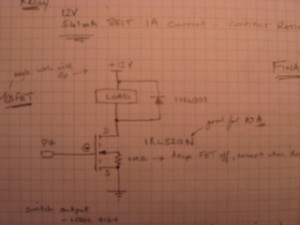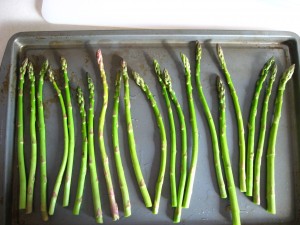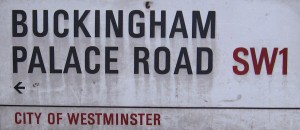As the stock market fluctuates, a prime time to use the Dow Jones as a sensor input.
Monday, November 24, 2008
Sunday, November 2, 2008
Breadboard Power Supply 5V/3.3V
A very simple breadboard power supply kit that takes power from a DC wall wart and outputs a selectable 5V or 3.3V regulated voltage. The .1" headers are mounted on the bottom of the PCB for simple insertion into a breadboard. Pins labeled VCC and GND plug directly into the power lines. The lone pair of pins have no electrical connection but help support the PCB.
MOSFET for solenoid drivers
Saturday, November 1, 2008
rust never sleeps
Saturday, October 4, 2008
whatscookinggrandma.net
safe to pee! and other PHP projects
chicagocrime.org crime in the city 2006-7
Friday, October 3, 2008
Atari Joystick as controller for ROV
To control the motors on an ROV, maybe use an old Atari joystick, and here are the schematics.
Electronic lock uses a mobile phone
E-Lock is a touch tone activated electronic combination lock which is controlled by the keypad of a mobile phone. When the correct combination is entered, a relay on the E-Lock circuit board is activated. The relay can be connected to a solenoid (not included) controlling the lock on a door or cupboard. To operate the E-Lock, just hold your mobile phone close to the built in microphone and then enter the lock combination on the phone keypad all at apogge kits
Saturday, September 6, 2008
conductive thread, ink, fabrics
[caption id="" align="alignnone" width="250" caption="Arduino Lilypad"]
 [/caption]
[/caption]
bit.fall water sculpture
Amazing falling water writing words from bit.fall from Julius Popp
Monday, September 1, 2008
fittings
Sunday, August 31, 2008
waterproof boxes
 Pelican cases are the ultimate underwater enclosure, but what about Otterboxes?
Pelican cases are the ultimate underwater enclosure, but what about Otterboxes?
Tuesday, August 26, 2008
microfiche reader
Monday, August 25, 2008
processing and mapping coordinates
Sunday, August 24, 2008
processing
before I forget about an incredible exhibit at MOMA, called Design and the Elastic Mind. Lots of uses of processing language and some great processing of geographic data
Friday, August 22, 2008
arduino glockenspiel
 Intersting glockenspiel driven by an Arduino. USes solenoids and are powered by arduino
Intersting glockenspiel driven by an Arduino. USes solenoids and are powered by arduino
http://www.thebox.myzen.co.uk/Hardware/Glockenspiel.html![]()
underwater sampling system
 Starting the design for a medium volume (3L) underwater sampling system. A place for 12 vdc solenoid valves , or maybe the KIP versions now just need to find flow controllers and totalizers.
Starting the design for a medium volume (3L) underwater sampling system. A place for 12 vdc solenoid valves , or maybe the KIP versions now just need to find flow controllers and totalizers.
Wednesday, August 20, 2008
tufa
tufa ideas from
http://www.the-artistic-garden.com/index.html
Sculpting Recipe
Here is a recipe that will give you a durable, carvable and long lasting hypertufa sculpture. Your aim is to apply this first recipe in thin layers over your armature, building it up to the desired thickness. Then, you will use the 2nd recipe to add one or more layers thick enough to allow you to sculpt to your desired depth.
Recipe for application over the armature
and to build up thickness desired:
1 part Portland cement
1½ parts peat moss
1½ parts coarse sand
Handful of poly fibers
Handful of silica fume
Recipe for the Final Layer(s)
1 part Portland cement
1 part peat moss
1 part coarse sand
Elmer's Carpenter's Exterior Wood Glue
(or other bonding agent)
papier mache artists
Thinking about some papier mache ideas for the next sculpture. Eith using it or tufa (mixture of peat moss and cement)
Some great work at http://www.papiermache.co.uk/gallery/
Jilly Tinniswood, intersting papier mache inspired sculptures 
Cheap and indispensable. No release agent needed. The balloon will tear itself away from your dried papier mache easily when burst.
Bowls and plates
These will need to have a release agent applied first to stop the papier mache sticking to them.
Release agents
These all must be applied very thinly. They may leave a small residue, which you may not like.
- Vaseline
- Cooking oil
- Washing up liquid
When completely dry, paint with two coats of emulsion paint to seal it and kill the newsprint. You could also use gesso for a slightly tougher base.
craftsman style fence and railing
beautiful Arts & Crafts style fences and railings.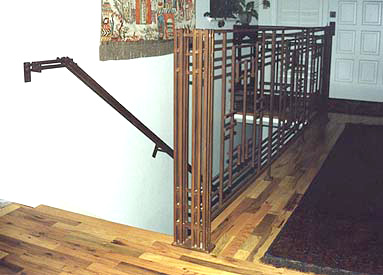
http://www.lmnoarts.com/Portfolio/FR-CraftsmanInteriorRailing.htm
and some great fences by http://www.kirsch-korff.com/
Sunday, August 17, 2008
small servos, gears and joysticks
pan and tilt system for cameras or servos and small joystcks and also have gears and mechanics for servos
bs2 program for ping)))
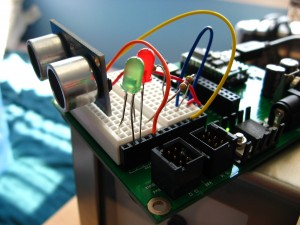
Using the PING))) ultrasonic sensor I can change LEDs flashing colors with changing distance of a person.
Saturday, August 16, 2008
distance ranging and detection
First I need to detect that someone is in the room (which activates a response from the sculpture).
Then I need to measure the distance of the observer from the sculpture, as the closer someone gets the different responses will be realized.
This distance detection could be either from an ultrasonic sensor
(from Parallax), or the low cost infra-red detectors from Sharp which are available at http://www.acroname.com/robotics/parts/R48-IR12.html
multiple servo control from PC
Tuesday, August 5, 2008
new book arrived
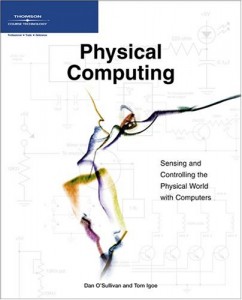 [/caption]
[/caption]Physical Computing by Dan O'Sullivan and Tom Igoe arrived. Tom Igoe has some amazing work on the web and his students at NYU have pushed physical computing to some amazing heights. Should give me a lot to think about with microcontrollers and linking them to computers

